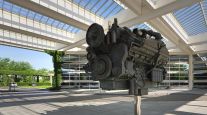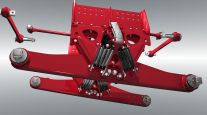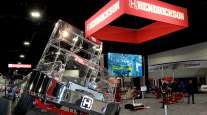Steer Axle Suppliers Focus on Weight Reduction
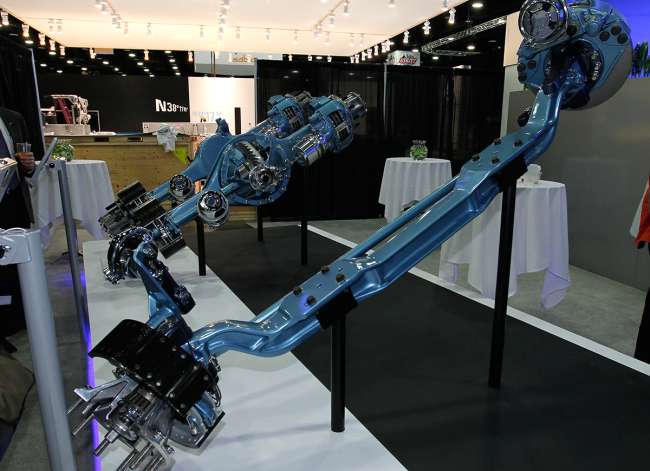
Shaving off weight has become a central objective of truck component design, and nowhere is that “lightweighting” trend more apparent than on the front axle.
Several suppliers have introduced lighter steer axles in recent years as part of a broader effort to counter the increased weight of aftertreatment systems added to trucks to meet emission regulations.
RELATED: Automated steering is the next step
Meanwhile, rising customer interest in front-axle disc brakes has led axle suppliers to look to the brake mounting in the search of weight savings.
Dana Holding Corp. has released a new lightweight family of axles in its E-Series where it redesigned the axle beam, which has been optimized for weight, said Steve Slesinski, director of product planning. Dana’s D-Series steer axle also uses the lightweight beam and integrates the air disc brake to the brake mounting knuckle.
The redesign of the E and D series was aimed primarily at offsetting the added weight of engine aftertreatment systems, but the overall weight reduction yields other benefits as well, Slesinski said. “On the steer axle, if you can provide a weight balance on the front of the truck, you can avoid having to go to higher-rated and more expensive steer-axle tires.”
Meritor, another major supplier of steer axles, also recently redesigned its front axle to reduce weight, as well as the complexity in the air disc brake application.
The MFS+, the latest generation of Meritor’s front axle, is a recent example of the company’s move to reduce weight, said Ryan Obert, Meritor’s director of product marketing.
“It features integrated torque plates and tie-rod arms,” he said. “We were first to market with this type of design, and it offers our customers a lighter-weight, easier-to-service axle while maintaining durability and performance.”
Dana and Meritor aren’t the only steer axle suppliers.
Detroit, Daimler Trucks North America’s captive powertrain supplier, offers a range of steer axles used in DTNA’s Freightliner and Western Star trucks.
Similarly, Paccar Inc., the parent company of Kenworth and Peterbilt brand trucks and the supplier of Paccar engines and components for those trucks, launched a steer axle in recent months.
The Paccar front axle is available with ratings of 20,000 or 22,000 pounds “and uses an innovative tapered kingpin roller bearing which simplifies the design and delivers enhanced steering efficiency,” Landon Sproull, Paccar vice president and past chief engineer at Peterbilt, said at the launch of the axle line last year. The tapered kingpin roller bearing delivers reduced steering effort for the driver, Sproull said.
This roller bearing feature also is included on the axles from Detroit.
Detroit offers axles in three series with varying weight ratings. The lighter axles feature “a unique I-beam design” that helps enable a sharper wheel cut of up to 55 degrees, said Kelly Gedert, manager of Detroit powertrain and component marketing.
This tighter turning radius has become a standard for the industry.
All suppliers of lighter highway axles boast the same wheel cut of 55 degrees. This allows for tight turning and greater maneuverability that used to be the unique feature of the steer axles available in Volvo and Mack trucks, in addition to Dana and Meritor axles. Now all makes offer similar turning ability, which has increased the danger of crushing the cab side extenders or even cab corners in a tight maneuver.
One fleet has an answer for that: Mesilla Valley Transportation’s Jimmy Ray, co-founder of the Las Cruces, N.M.-based truckload carrier, said his company paints a vertical red line on the trailer side. If a driver loses sight of that line in a turn, he is turning too tight and is instructed to back off the steering.
MVT ranks No. 72 on the Transport Topics Top 100 list of the largest for-hire carriers in North America.
While all the previously mentioned axles are steel forgings, the SteerTek steer axle from Hendrickson is a steel fabrication, a square section with a hollow center. It also has a unique two-piece steering knuckle that allows for quick king-pin bushing replacement.
This makes the SteerTek axle a boon to the second or third owner of a truck who is contemplating replacing king-pin bushes to cure worn and wandering steering, said Gerry Remus, Hendrickson’s general manager of sales and business development.
“The front axle represents a tremendous way to take weight off the front end of the truck,” Remus said.
The SteerTek NXT is the latest iteration of a 14-year-old design and offers additional weight savings over a forged I-beam axle.
“There’s a number of different steer axles out there. If you’re just comparing the axle beam to the axle beam, the fabricated axle saves 10 to 12 pounds,” Remus said.
Hendrickson sells the SteerTek axle to truck manufacturers to use with its proprietary front suspension, or Hendrickson will package the fabricated axle into its AirTek NXT, an integrated air suspension engineered for the axle.
“The real value of what you can do with a fabricated axle comes into play there,” Remus said. “As we’re not bound by normal constraints of a forged I-beam axle, we’re able to integrate the axle into the suspension and remove conventional components such as the traditional axle seat.”
The AirTek product offers “a significant weight advantage,” Remus said, noting it went into production in the second quarter on Freightliner’s new Cascadia model and saves at least 80 pounds versus a typical I-beam.
The AirTek combines an air spring with steel monoleaf suspension. But Hendrickson is developing composite springs to offer with the AirTek, one using just the composite spring and another using the composite springs with air bag. That’s because future greenhouse gas regulations may dictate a variable ride-height front suspension, Remus said.
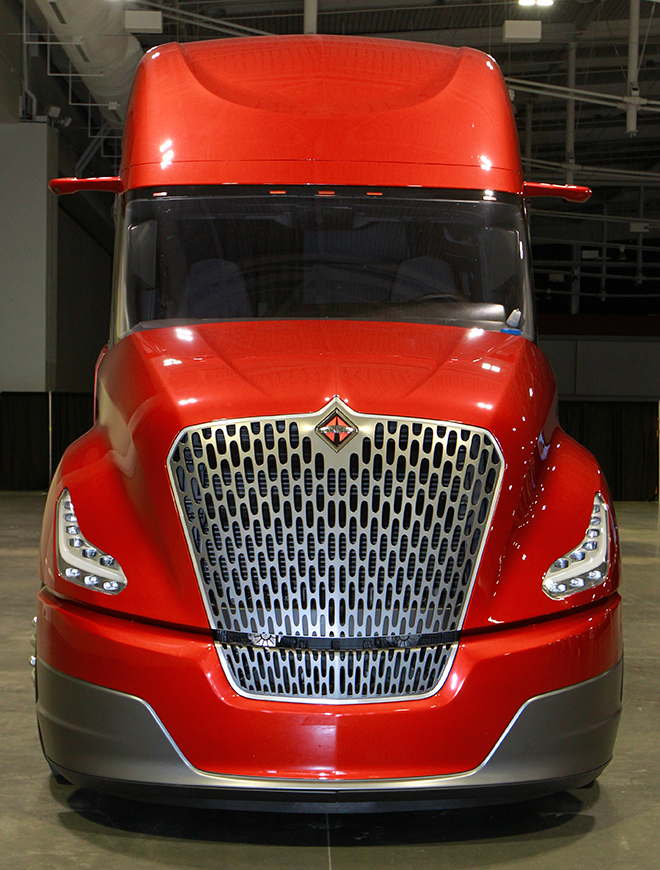
Navistar International CatalIST (John Sommers II for Transport Topics)
That vision of the future has played out in the International CatalIST SuperTruck concept vehicle that Navistar Inc. unveiled last summer.
“The axle on SuperTruck is a lightweight SteerTek with integrated knuckles to support the Wabco front disc brake, which are in production in Europe,” said David Terry, communications manager at Navistar, maker of the International brand truck. “The suspension is a prototype hybrid design with fiber composite leaf spring and air bag, similar to the Hendrickson AirTek product.”
The conventional Hendrickson AirTek axle and suspension are in production at Navistar today, minus the disc brake integrated knuckle, Terry said.
Composite springs are not new. At Liteflex, they have been in production since 1981 and are featured on many makes of semi-trailers, cars and light trucks. Notably, the front spring on the Daimler Sprinter van is a LiteFlex composite.
However, the last change to the federal motor vehicle safety standard for stopping distance that went into effect in 2013 presented challenges. The Liteflex spring option has not been available since, but the company has since redesigned its composite springs, said CEO John Prikkel, who added that he is negotiating to make the springs available with several truck manufacturers.
Because the spring is one-third the weight of steel, “you get a better ride, it doesn’t go flat over time or at 2 million miles,” Prikkel said. “Many drivers will tell you composite springs improve the ride of the tractor.”
One fleet said composite springs also benefit tire wear. An endorsement by Sentinel Transportation speaks to steer tire wear with the Liteflex composite springs.
“We have seen their tire life increase two to three times after replacing the steel springs on our Eaton 1202 steer axles with Liteflex lightweight composite spring,” wrote Orville White, Sentinel’s fleet manager. “We used to get 75,000 to 90,000 miles from our steer axle tires. Now we’re seeing [200,000 to] 250,000 miles before pulling the tires.”


